Star-Advertiser photographer embarks on journey to capture great white shark

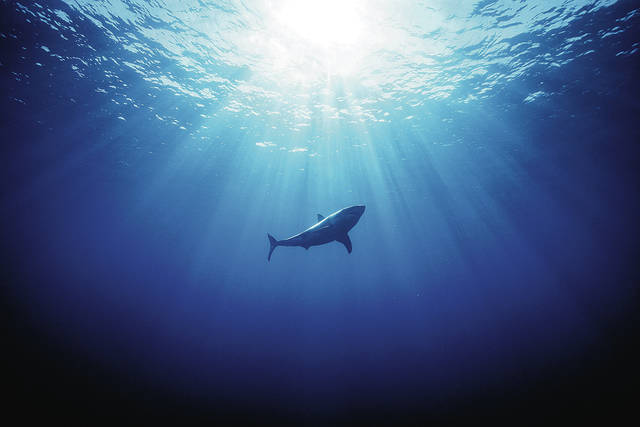
JAMM AQUINO / JAQUINO@STARADVERTISER.COM
Photographer Jamm Aquino captured a dream-come-true image of a great white shark in silhouette while swimming off Mexico’s Guadalupe Island in October.
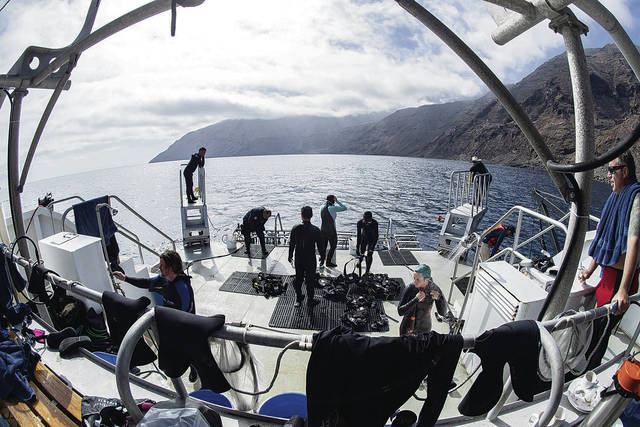
JAMM AQUINO / JAQUINO@STARADVERTISER.COM
The dive deck of the Nautilus Explorer off Mexico’s Guadalupe Island.
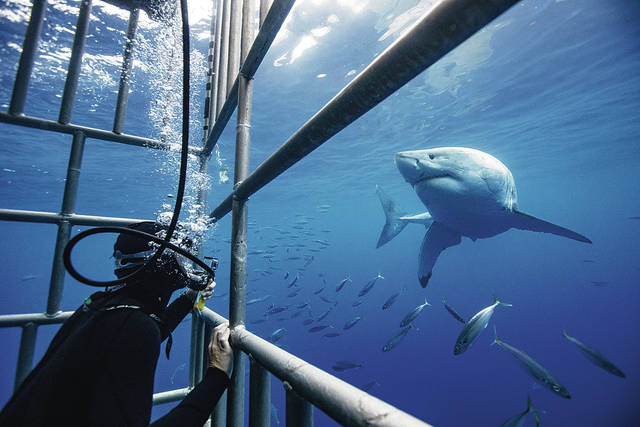
JAMM AQUINO / JAQUINO@STARADVERTISER.COM
Andrea Franceschelli of Bologna, Italy, watches a 17-foot female white shark named Scarboard.
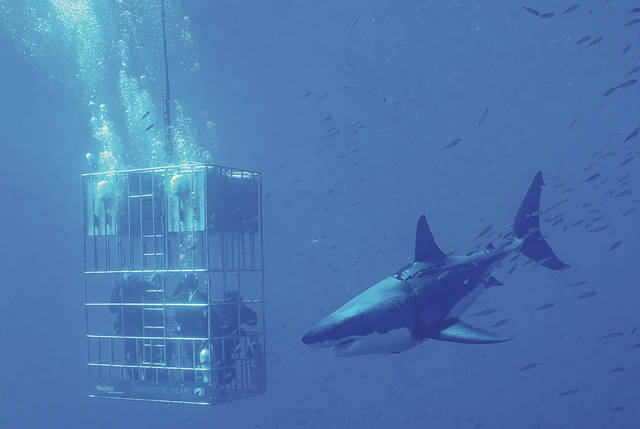
JAMM AQUINO / JAQUINO@STARADVERTISER.COM
A female white shark named Ropey swims nears divers in a submersible cage off Mexico’s Guadalupe Island. From August through December, divers and adventurers travel to this remote island 250 miles southwest of San Diego to come face to face with great white sharks.
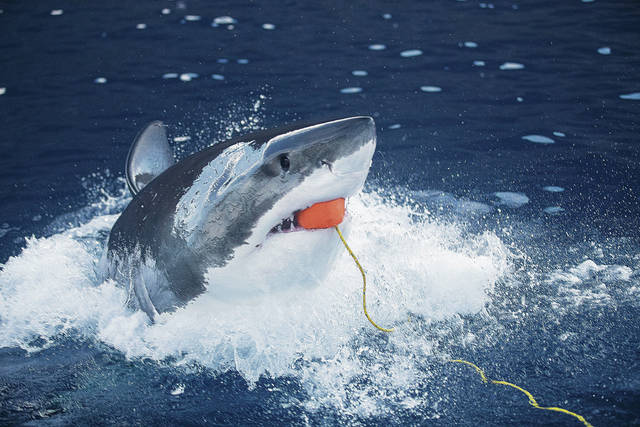
JAMM AQUINO / JAQUINO@STARADVERTISER.COM
A white shark breaks the surface of the water whilechasing a lure.
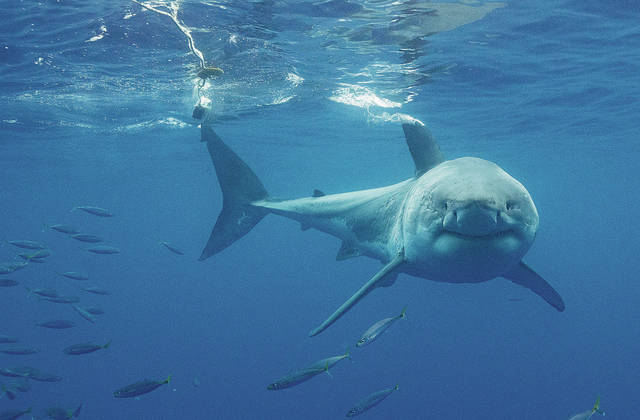
JAMM AQUINO / JAQUINO@STARADVERTISER.COM
A 17-foot female white shark named Scarboard turns after pursuing a tuna bait.
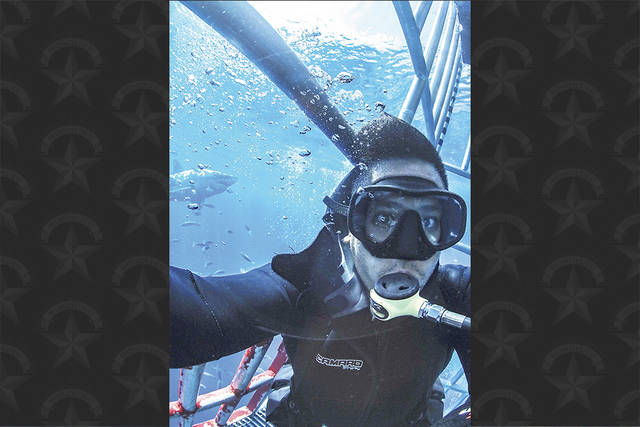
JAMM AQUINO / JAQUINO@STARADVERTISER.COM
Jamm Aquino paused for an underwater selfie.








As I peered down from the steel cage, the cobalt abyss faded to blackness beneath me. Above, the sun’s rays pierced through the water like a natural spotlight for the creature that was fast approaching — a great white shark.
I huddled with three others in the 65-degree Pacific Ocean water, mesmerized by the perfect predator. The curious 13-foot male shark came within about a yard of us before gracefully turning away. Then just as silent and quickly as he had come, he disappeared with barely the flick of a tail.
This scene repeated over and over again during the next three days, each encounter evoking just as much excitement and adrenaline as the first time.
I was among 25 vacationing divers who had traveled aboard the Nautilus Explorer, a 132-foot luxury ship, to the remote Pacific island of Guadalupe, about 250 miles southwest of Ensenada, Mexico, for what many divers consider to be the ultimate underwater encounter.
I came to fulfill a dream I’ve had since childhood — sharing the water with great white sharks — but having photographed other species of sharks before, I also came with the vision of the ultimate shot capturing this extreme shark encounter. My expectations were high.
SHARKS AT GUADALUPE ISLAND
Don't miss out on what's happening!
Stay in touch with breaking news, as it happens, conveniently in your email inbox. It's FREE!
>> Great white shark season at Guadalupe Island is from mid-July through November. Satellite technology has shown white sharks are migratory animals and spend much of their time in the open ocean between Hawaii and California when not at Guadalupe.
>> In the Mexican waters, the number of male sharks, which are smaller in size (10-15 feet), peaks July to September. September through November sees the arrival of mature female sharks, some up to 18-20 feet long.
After sailing for 20 hours from the Mexican coast, the Nautilus Explorer arrived at the northeastern bay of Guadalupe and anchored about 400 yards from shore. The nighttime arrival was surreal, with a full moon illuminating the island’s rocky terrain, rising to 4,000 feet above sea level.
Excitement was thick upon arrival as most of the divers had never seen a great white shark. One couldn’t help but imagine that beneath us at that very moment, a shark was swimming by.
At 5 a.m., before the sun rose, the ship was abuzz: Divers were getting into wetsuits and rinsing masks; cameras were being tested. Then we heard it.
“Shark!” dive master Hector Peredo yelled in what would soon be a familiar cry.
ACTION ON deck hastened, and divers queued up to enter the cages as the sky brightened to a pinkish orange. Despite the thrill of anticipation, the move to the cage was quite slow as each diver had to be harnessed with 30 to 40 pounds of weights so we could stand comfortably in the shark cage.
IF YOU GO: NAUTILUS LIVEABOARDS GUADALUPE ISLAND
>> Getting there: All expeditions begin and end in San Diego, Calif., where Nautilus will shuttle the group over the border to the port in Ensenada, Mexico. Take a direct flight to San Diego, ideally the day before the departure of your trip, with an overnight stay at San Deigo’s Best Western Plus Island Palms resort (bestwestern.com), which serves as the Nautilus rendezvous point.
>> Cruise: Most trips are booked up to a year in advance. Rates range from $2,795 to $4,195 per person. Each room comes with its own full bathroom and shower. Trips are rarely canceled, but because of the unpredictability of events such as storms and hurricanes, dive trip insurance is recommended.
>> Phone: 888-434-8322
>> On the net: nautilusliveaboards.com/guadalupe
>> Notes: No prior scuba experience is necessary for surface cages. Basic open-water scuba certification is required for submersible cages. Water temperature is quite chilly by Hawaii standards — around 60-70 degrees, so a 5- to 7-millimeter full wetsuit is highly recommended, along with boots, gloves and a hood. Photographers who take the plunge should be sure to do a couple of dives without cameras in hand, to soak up the experience completely.
The four shark cages on the ship, each measuring about 12 feet high, 8 feet long and 6 feet wide, has a ladder to make entering and exiting easy. Two “surface cages” sit at a depth of 10 feet and two submersible cages are lowered to a depth of 30 feet.
My initial dive was in a port-side surface cage. Climbing down the ladder slowly, I found myself fully submerged by the third rung. Breathing through my regulator with air supplied from the ship, I oriented myself as the pressure in my ears equalized, and I had my first look around.
The sharks congregate naturally near to the island between mid-July and November as part of a yearly migration. On my October trip, I was not disappointed.
As many as five sharks swam around us at one time. The first time I locked eyes with these often-vilified apex predators, it was spellbinding. The eye of a white shark isn’t black and lifeless; it has a deep blue iris that shows its inquisitiveness and intelligence.
Some sharks swam so close I could reach out and touch them. Two hours later I emerged, energized by the experience. It is intoxicating to connect to such a regal animal.
Over the three days we were at anchor at Guadalupe Island, time in the surface cages from dawn until dusk was limited only by our own desires. Submersible cages were available on a 45-minute rotation among those who had their scuba certification, with up to four divers occupying a cage.
It was in one of these submerged cages, away from the commotion of the boat and surface cages, that the sharks approached us freely. It was here, on the third day and the last dive before we headed back, that I got the shot of the trip.
Although I had photographed and observed more than 20 sharks at that point, I had yet to catch that elusive moment when sun, ambient light and water conditions lined up to create a perfect silhouette of a white shark against nothing but cobalt blue. There were instances that came close, but either the shark, the sun or my position wasn’t correct. It was a game of nerves and perfection. I was getting frustrated.
BUT THEN it happened.
WHAT TO BRING
>> Dive-related equipment: Mask, swimsuit or boardshorts (to wear inside your wetsuit), slippers, sunscreen (preferably non-aerosol and biodegradable). Wetsuits with boots, gloves and hoods are available to rent from the ship. Inquire when booking your reservation.
>> Photo/video equipment: GoPro or similar underwater camera, batteries and chargers, plenty of digital memory. A wrist strap is highly recommended for any camera, as currents are sometimes sudden and can sweep cameras out of the cage and into open water where they cannot be retrieved. Drones are allowed, but at the captain’s discretion.
>> Medication: Motion-sickness medication, such as Dramamine, ginger pills, etc., is highly recommended, even if you are not prone to seasickness. The dive site at Guadalupe is fairly calm as it’s in a protected bay, but the open-ocean crossing each way can be rough.
>> Clothing: The 70-80 degree temperatures by day, dipping to 55-65 at night are typical. A light sweater and/or sweatpants are appropriate onboard during evening hours. Most days will be spent in a swimsuit and/or boardshorts. Rain is unlikely, although fog can creep over the island and provide light mist. Polarized sunglasses aid shark observation from the ship. Also, a hat is ideal to protect you from the sun while on deck.
>> Miscellaneous: A book or ebook reader and/or laptop or tablet to watch movies, as the voyage to and from Guadalupe is 20 hours each way. The Nautilus Explorer has a flatscreen television and an extensive collection of blu-ray and DVD movies to watch in the lounge. Bring cash, for the Mexican national park and port fees, $60 per person, (Guadalupe is a government-protected biosphere) and for crew gratuities, typically 10-15 percent of the trip’s total cost. Purchases on board, such as alcohol and souvenirs, can be charged to a credit card. Onboard Wi-Fi is available for purchase, but the beauty of the trip is being able to disconnect.
A 15-foot male great white was taking close passes at our cage. As the sun started to sink over the island, the schools of mackerel scad and yellowfin tuna — which had all been omnipresent — had vanished. I stared into the perfect gradient blue, but alas, no shark. Then, as if on cue, he appeared.
The sun’s rays played like a spotlight as the large male moved into position, almost in slow motion. I pressed the shutter button, my hands trembling with excitement. This was it. It was a shot I had envisioned years ago even as I was planning this trip.
The shark turned, as if knowing it had satisfied my need, and disappeared into the deep. I looked at the back screen of my camera and screamed through my regulator. It was time to ascend.
At the end of each dive day, guests would often soak in the hot tub on the upper deck of the ship, sometimes with a cold beer or cocktail from the ship’s full-service bar. The 10 crew members of the Nautilus Explorer made sure all dive operations ran impeccably — from prepping tuna baits to lure sharks (it is illegal to chum at Guadalupe) to lowering and raising the submersible cages, and catering to all the divers’ needs. Breakfast and lunch were even served on deck as you sat in your wetsuit if you so desired.
At the end of the third day of diving, everyone bid a melancholy farewell to the sharks that we had gotten to know, some by name. The cages were secured for the 22-hour journey back to Ensenada, Guadalupe’s famous Sharkfin Rock fading in the distance against a tangerine sunset.
Over the diving days, we identified 27 great whites that came to visit the Nautilus Explorer. I spent close to 28 hours in the water, though I didn’t quite break the cruise record of 31.5 hours of cage time.
One of the most important aspects of the trip is the awareness you gain that the great white shark — the most infamous animal in the sea — does not deserve its reputation. Not once did I feel aggression or danger from the sharks that visited us. In fact, most approached cautiously. I only saw an open mouth or bared teeth when the sharks would take interest in the hanging tuna baits.
With our oceans in an escalating state of peril from global warming and human impact, the experience in the cobalt abyss of Guadalupe is priceless.
Jamm Aquino is a Star-Advertiser photographer, avid traveler and shark enthusiast. To see more great white sharks, including video and behind-the-scenes photos, follow Jamm Aquino on Instagram at @jammaquino Opens in a new tab.




